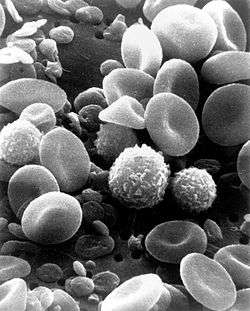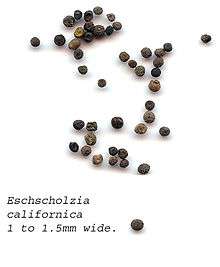Orders of magnitude (less than one cubic millimetre)
The following is a table of objects with volumes or capacities of other less than one cubic millimetre.

chain structures in meteorite fragment ALH84001

electron micrograph of icosahedral adenovirus

a scanning electron microscope image of normal circulating human blood showing red blood cells, several knobbly white blood cells including lymphocytes, a monocyte, a neutrophil and many small disc-shaped platelets

scanning electron micrograph of a human red blood cell, a platelet and a leukocyte (from left to right)
.jpg)
monocytes under a light microscope surrounded by red blood cells

California poppy seeds
| volume (m3) | example |
|---|---|
| 4.22419×10−105 | the Planck volume |
| 1×10−72 | one cubic yoctometre |
| 1×10−63 | one cubic zeptometre |
| 1×10−54 | one cubic attometre |
| 1×10−45 | one cubic femtometre |
| ~9.4×10−44 | classical volume of an electron |
| ~1.5×10−41 | volume of a proton |
| 1×10−36 | one cubic picometre |
| 1×10−30 | one cubic ångström |
| 7.23×10−30 | volume enclosed by the van der Waals radius of a hydrogen atom |
| 3.936×10−29 | van der Waals volume of a helium atom |
| 1.91×10−29 | volume enclosed by the van der Waals radius of a gold atom |
| 3.75×10−29 | van der Waals volume of a H 2 molecule |
| 6.50×10−29 | van der Waals volume of a N 2 molecule |
| 5.29×10−29 | van der Waals volume of a O 2 molecule |
| 9.34×10−29 | van der Waals volume of a Cl 2 molecule |
| 1×10−27 | one cubic nanometre or one yoctolitre |
| 1×10−24 | one zeptolitre |
| 5×10−23 | typical volume of structures on the Martian meteorite ALH84001 |
| 1×10−21 | one attolitre |
| 4×10−21 | volume of hypothesised nanobacteria |
| 5×10−21 | volume of a typical virus |
| 1×10−18 | one cubic micrometre or one femtolitre |
| 9×10−18 | average volume of a platelet |
| 9×10−17 | normal volume of a human red blood cell |
| 1×10−16 | volume of an enlarged red blood cell (macrocytosis)[1] |
| 2×10−16 | average volume of a lymphocyte |
| 3.3×10−16 | mean volume of a neutrophil granulocyte |
| 4.2×10−16 | volume of an average monocyte |
| 1×10−15 | one picolitre |
| 2–9×10−15 | one drop from a high resolution colour inkjet printer |
| 1.3×10−13 | a very fine grain of sand (0.063 mm diameter, 3 micrograms) |
| 1×10−12 | one nanolitre |
| 6.2×10−11 | a medium grain of sand (0.5 mm diameter, 1.5 milligrams) |
| 5×10−10 | volume of a poppy seed of 1-millimetre diameter[2] |
| one cubic millimetre to one cubic metre → | |
References
- ↑ Nibbering, P. H., T. P. L. Zomerdijk, A. J. Corsèl-Van Tiburg, and R. Van Furth. 1990. Mean cell volume of human blood leucocytes and resident and activated murine macrophages. J. Immunol. Methods 129:143-145 .
- ↑ Gerald H. Ristow (2000). Pattern Formation in Granular Materials. Springer. p. 193. ISBN 3-540-66701-6. Retrieved 3 November 2008.
This article is issued from Wikipedia - version of the 11/9/2016. The text is available under the Creative Commons Attribution/Share Alike but additional terms may apply for the media files.